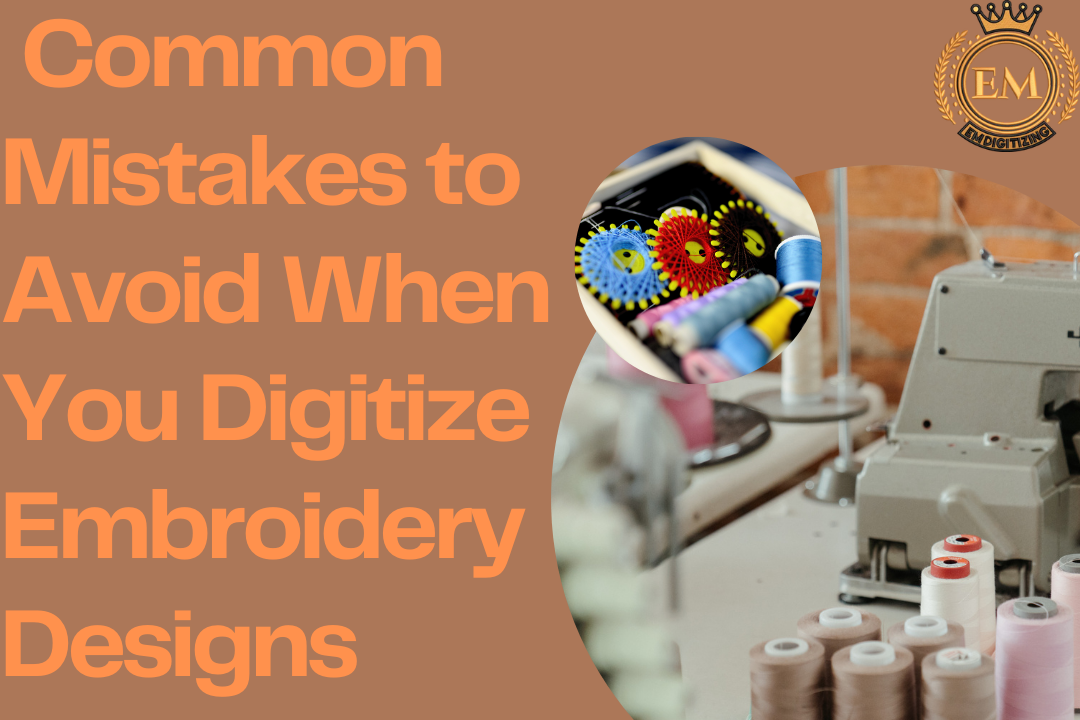Common Mistakes to Avoid When Digitizing Embroidery Designs

Strong 8k brings an ultra-HD IPTV experience to your living room and your pocket.
When you digitize embroidery designs, precision is key to achieving high-quality embroidered products. Whether you're a beginner or an experienced digitizer, errors can compromise the final stitch-out. In this guide, we’ll highlight the most common mistakes to avoid when you digitize embroidery designs and how professional Embroidery Digitizing Services can help ensure precision. Our website provides expertly digitized embroidery designing files compatible with various embroidery software, ensuring seamless stitching results.
1. Using Low-Quality Artwork
A poor-quality image results in a poorly digitized embroidery design. Always start with a high-resolution image to ensure clean and crisp stitches.
How to Avoid This Mistake:
Use vector images or high-resolution raster images.
Avoid blurry or pixelated images.
Refine the image before digitizing it.
2. Ignoring Stitch Density
Incorrect stitch density can lead to puckering, distortion, or thread breakage. If stitches are too dense, they can cause fabric damage, while low-density stitches may appear incomplete.
How to Avoid This Mistake:
Adjust stitch density based on fabric type.
Avoid excessive overlapping stitches.
Test the design before final production.
3. Choosing the Wrong Stitch Type
Different stitch types serve different purposes. Using the wrong type can affect the quality and durability of the embroidery.
How to Avoid This Mistake:
Use satin stitches for lettering and small details.
Opt for fill stitches for large areas.
Utilize running stitches for outlines and fine details.
4. Poor Underlay Stitching
Underlay stitches provide structure and stability to embroidery. Skipping or incorrectly placing underlay stitches can cause misalignment and uneven embroidery.
How to Avoid This Mistake:
Choose the appropriate underlay type for different fabrics.
Use edge-run underlay for thin fabrics and tatami underlay for thicker materials.
Test the design on a sample fabric.
5. Ignoring Fabric Type and Hooping Technique
Not all fabrics react the same way to embroidery. Stretchy or delicate fabrics require special attention.
How to Avoid This Mistake:
Adjust stitch settings according to fabric type.
Use stabilizers to prevent fabric shifting.
Ensure proper hooping to maintain fabric tension.
6. Overlooking Thread and Needle Selection
The wrong thread or needle can lead to thread breakage, skipped stitches, or inconsistent embroidery results.
How to Avoid This Mistake:
Match thread type with fabric type.
Use high-quality embroidery threads.
Select the right needle size and type.
7. Not Testing the Design Before Production
Skipping the test run can result in unexpected errors in the final product.
How to Avoid This Mistake:
Always run a test stitch on a similar fabric.
Make necessary adjustments before bulk production.
Seek professional Embroidery Digitizing Services for expert guidance.
8. Neglecting Proper Software Settings
Embroidery digitizing software offers numerous settings, and incorrect configurations can impact stitch quality.
How to Avoid This Mistake:
Familiarize yourself with your embroidery software.
Adjust pull compensation to account for fabric stretch.
Regularly update software for optimal performance.
Conclusion
Digitizing embroidery designs requires careful attention to detail to avoid common mistakes that can impact the final result. By using high-quality artwork, selecting appropriate stitch settings, and testing designs before production, you can achieve professional-grade embroidery. Our website provides expertly digitized embroidery designing files that are compatible with various embroidery software, ensuring seamless stitching and superior results. If you need professional assistance, our Embroidery Digitizing Services are here to help bring your creative visions to life with precision and accuracy.
FAQs
Q1: What is the best software for embroidery digitizing?
There are several embroidery digitizing software options available, including Wilcom, Hatch, and Brother PE-Design. Choose one that suits your needs and skill level.
Q2: How do I improve my embroidery digitizing skills?
Practice regularly, experiment with different stitch settings, and consider using professional Embroidery Digitizing Services for high-quality results.
Q3: Can I digitize embroidery designs myself?
Yes, but it requires knowledge of embroidery software, stitch techniques, and fabric behavior. Beginners may benefit from outsourcing to professional Embroidery Digitizing Services.
Q4: Why does my embroidery design look distorted?
Distortion may occur due to incorrect stitch density, poor underlay stitching, or improper hooping. Always test your design before final production.
Q5: How do I prevent thread breakage in embroidery?
Use high-quality threads, choose the correct needle size, and adjust stitch settings to reduce tension and friction.
Note: IndiBlogHub features both user-submitted and editorial content. We do not verify third-party contributions. Read our Disclaimer and Privacy Policyfor details.


